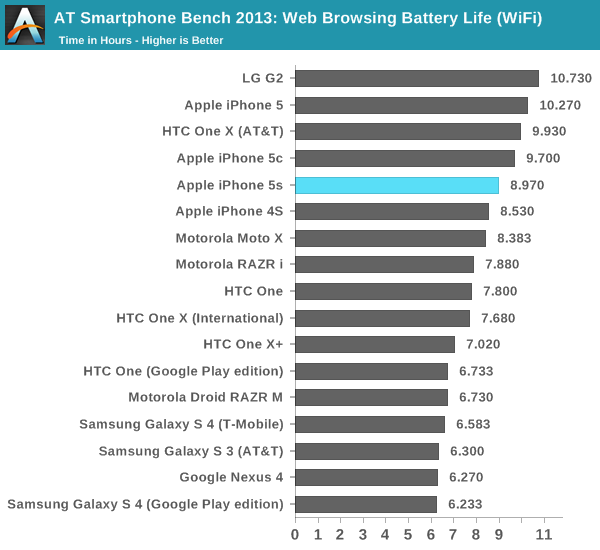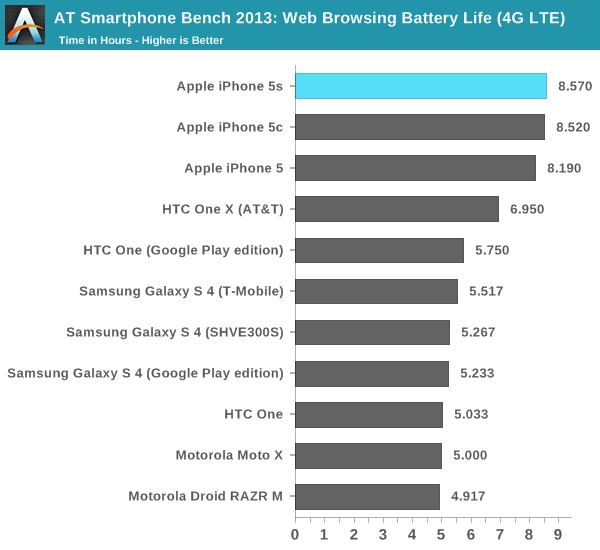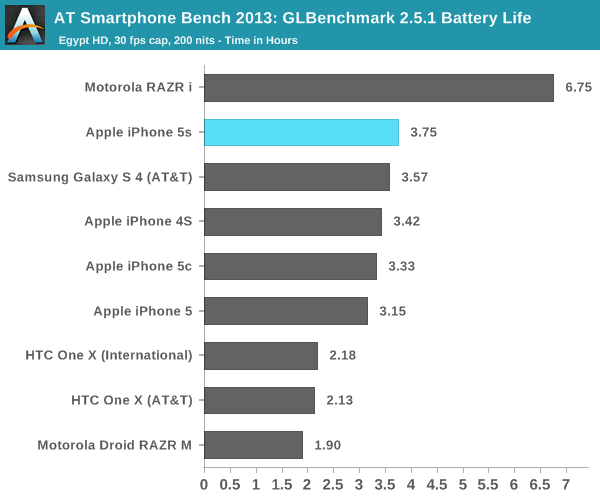The iPhone 5s Review
by Anand Lal Shimpi on September 17, 2013 9:01 PM EST- Posted in
- Smartphones
- Apple
- Mobile
- iPhone
- iPhone 5S
Battery Life
Brian did some excellent sleuthing and came across battery capacities for both the iPhone 5s and 5c in Apple’s FCC disclosures. The iPhone 5 had a 3.8V 5.45Wh battery, while the 5s boosts total capacity to 5.96Wh (an increase of 9.35%). The move to a 28nm process doesn’t come with all of the benefits of a full node shrink, and it’s likely not enough to completely offset the higher potential power draw of a much beefier SoC. Apple claims the same or better battery life on the 5s compared to the iPhone 5, in practice the answer is a bit more complicated.
Unlike previous designs, we’ve never had a half node shrink for an s-SKU. Both the iPhone 3GS and iPhone 4S stayed on the same process node as their predecessor and drove up performance. In the case of the 3GS, the performance gains outweighed their power cost, while in the case of the iPhone 4S we generally saw a regression.
The iPhone 5s improves power consumption by going to 28nm, but turns that savings into increased performance. The SoC also delivers a wider dynamic range of performance than we’ve ever seen from an Apple device. There’s as much CPU power here as the first 11-inch MacBook Air, and more GPU power than an iPad 4.
To find out the balance of power savings vs. additional performance I turned to our current battery life test suite, which we first introduced with the iPhone 5 review last year.
We'll start with our WiFi battery life test. As always, we regularly load web pages at a fixed interval until the battery dies (all displays are calibrated to 200 nits).

The iPhone 5s regresses a bit compared to the 5 in this test (~12% reduction despite the larger battery). We're loading web pages very aggressively here, likely keeping the A7 cores running at their most power hungry state. Even the 5c sees a bit of a regression compared to the 5, which makes me wonder if we're seeing some of the effects of an early iOS 7 release here.
The story on LTE is a bit different. Here we see a slight improvement in battery life compared to the iPhone 5, although the larger battery of the 5s doesn't seem to give it anything other than parity with the 5c:

Our cellular talk time test is almost entirely display and SoC independent, turning it mostly into a battery capacity test:

You can see the close grouping of the smaller iPhones at the bottom of the chart. There's a definite improvement in call time compared to the iPhone 5. We're finally up above iPhone 4S levels there.

Our Egypt HD based 3D battery life test gives us the first indication that Rogue, at least running fairly light code, can be more power efficient than the outgoing 5XT. Obviously the G6430 implemented here can run at fairly high performance levels, so I'm fully expecting peak power consumption to be worse but for more normal workloads there's no regression at all - a very good sign.










464 Comments
View All Comments
solipsism - Friday, September 20, 2013 - link
Across different browsers and/or OSes it's not when comparing the same OS and same browser on that OS the tests can be use to gauge HW improvements, as shown with the iOS7 and Safari on the iPhone 5 v. iOS7 and Safari on the iPhone 5S.solipsism - Friday, September 20, 2013 - link
Overall you're reading too much into it. It's just to gauge how something nearly everyone uses on a daily basis may have improved YoY between devices and OS updates. You can't deny the results are much improved even if you don't think the tests in and of themselves are viable measures of the browser's overall performance.HisDivineOrder - Friday, September 20, 2013 - link
Reminds me of the 3GS or the iPad 2. Its CPU and GPU are far overpowered compared to the underlying requirements of the display provided. In this way, they are set up for a future, higher resolution, better display where a more minor leap will progress them forward into a new product number (ie., iPhone 6).I imagine it will last as long as the 3GS and iPad 2, too. Those who bought an iPad 2 got an impressive lifespan for their product. Too bad Apple looks to make the iPhone 5 and iPad 3rd gen go bust far more quickly or people might think Apple products had a good long lifespan.
Also, kinda sad that Android is still so far ahead of iOS in all the ways that really matter in the here and now.
systemsonchip4 - Saturday, September 21, 2013 - link
Android is only ahead in marketshare, because Android is cheap, not that its great. iOS has Android and its manufacturers beat in just about almost every metric(customer satisfaction rating, most durable products, most loyal user base, etc...)Abhip30 - Tuesday, September 24, 2013 - link
lol. Its like saying a corolla has more marketshare then a mercedes. :Pnedjinski - Friday, September 20, 2013 - link
and then there are the realities that nobody seems to care about -http://www.wired.com/opinion/2013/09/ifixit-teardo...
iannoisrk - Friday, September 20, 2013 - link
Question on the geekbenchmark. Was it 32 bit code running on 64 bit isa or 64 bit code running? Most apps will probably run 32 bit code. Wonder what the numbers will look like for them.ka27orl - Friday, September 20, 2013 - link
can you do a review on BB10 devices please, e.g. Z30. I heard it beaten all quad core android phones in browsermark and performance tests.Harry_Wild - Friday, September 20, 2013 - link
I was very tempted to get the 5S but I knew Apple would not go all out on the A7 chip from previous iPhones. And now I am proven right! It only has 1GB RAM.I will wait patiently for the iPhone 6 and re-evaluate the phone market in mid-summer! I really like the gold color too!
systemsonchip4 - Friday, September 20, 2013 - link
So the iPhone 5S has 2 Cortex ARM-A57 cores clocked at 1.3 ghz roughly ... Amazing, thats why its able to beat out the S800 SoC